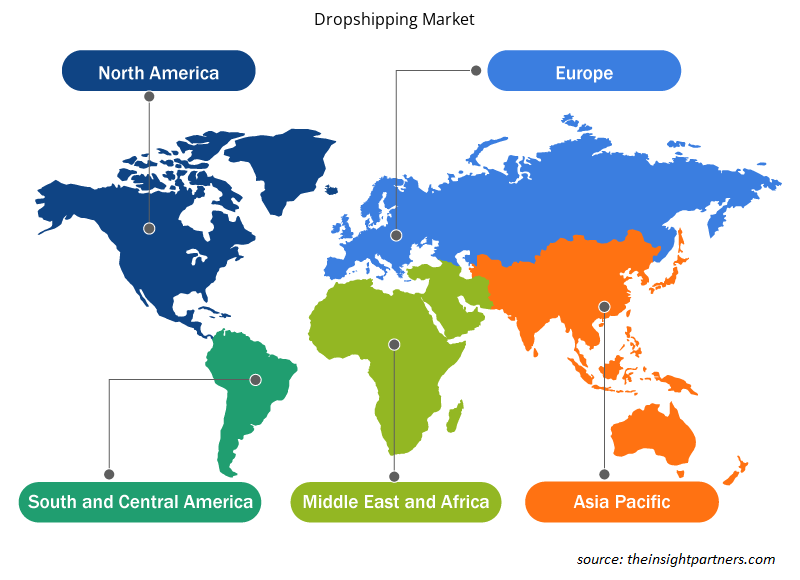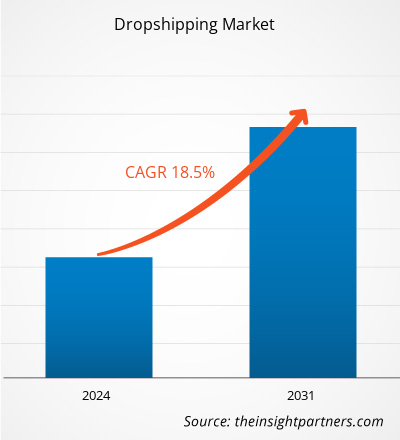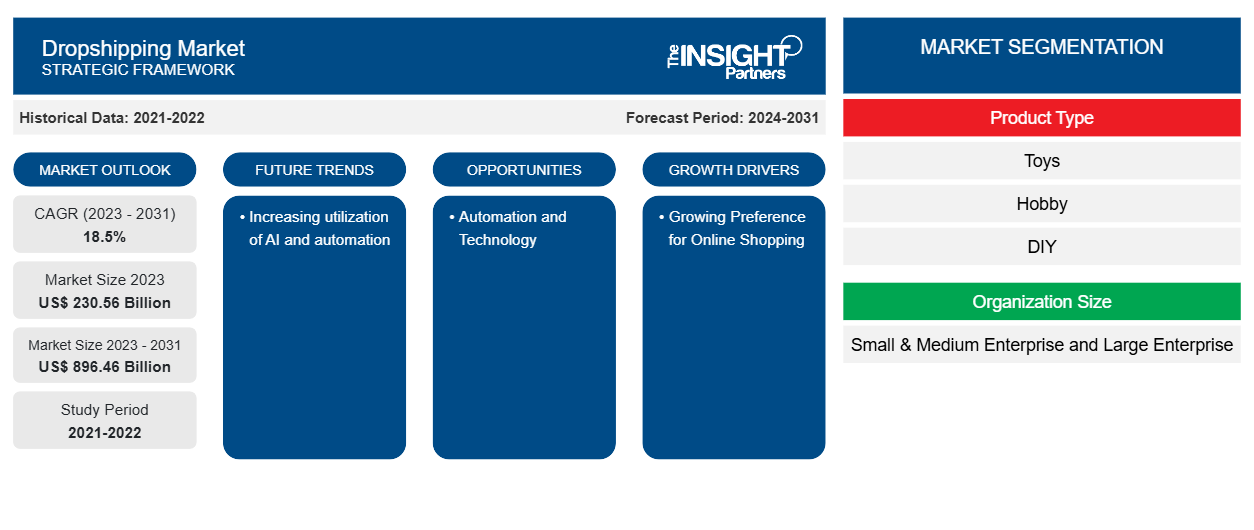Se espera que el tamaño del mercado global de dropshipping crezca de US$ 230,56 mil millones en 2023 a US$ 896,46 mil millones en 2031; se anticipa que se expandirá a una CAGR del 18,5% entre 2023 y 2031. Es probable que la creciente utilización de IA y automatización siga siendo una tendencia clave del mercado de dropshipping .
Análisis del mercado de dropshipping
El floreciente sector del comercio electrónico ha experimentado una enorme expansión en los últimos años, lo que ha impulsado el negocio del dropshipping . El auge de la industria del comercio electrónico ha facilitado a las empresas establecer tiendas en línea y acceder a una base de clientes mundial, lo que ha impulsado el mercado del dropshipping .
Descripción general del mercado de dropshipping
El dropshipping es un método de venta minorista en el que una empresa en línea no mantiene sus artículos en inventario. En cambio, cuando un consumidor realiza un pedido, la empresa lo envía junto con el pago a un proveedor de dropshipping . El proveedor luego envía los productos al consumidor . Muchos propietarios de empresas eligen el dropshipping porque permite a los proveedores manejar el cumplimiento de los pedidos. Esto implica que los minoristas no necesitan invertir en espacio de almacenamiento o correr el riesgo de quedarse atrapados con productos sin vender. Como resultado, las empresas pueden dedicar más recursos a otras operaciones minoristas, incluido el marketing.
Personalice este informe según sus necesidades
Obtendrá personalización en cualquier informe, sin cargo, incluidas partes de este informe o análisis a nivel de país, paquete de datos de Excel, así como también grandes ofertas y descuentos para empresas emergentes y universidades.
-
Obtenga las principales tendencias clave del mercado de este informe.Esta muestra GRATUITA incluirá análisis de datos, desde tendencias del mercado hasta estimaciones y pronósticos.
Factores impulsores y oportunidades del mercado del dropshipping
Creciente preferencia por las compras en línea para favorecer el mercado
El comercio electrónico está transformando el panorama minorista. Los hábitos de compra de las personas están cambiando rápidamente y comprar cualquier cosa en línea se está convirtiendo en la nueva norma. Esta expansión está siendo impulsada por una variedad de causas, incluido el desarrollo del comercio móvil, el auge de las redes sociales y la creciente popularidad de los servicios de suscripción. Los países de Asia-Pacífico y América del Sur están experimentando actualmente el desarrollo más rápido en el sector del comercio electrónico . Esto se puede atribuir tanto a la rápida adaptación de las nuevas tecnologías como a la estructura demográfica de estas naciones, que tiene más jóvenes que personas mayores. Estas generaciones más jóvenes son más expertas en tecnología y prefieren comprar en línea en lugar de fuera de línea.
Automatización y tecnología
El dropshipping es una estrategia comercial en la que el vendedor no mantiene inventario en stock, sino que envía los pedidos de los clientes y los datos de envío al fabricante, a otro comerciante o a un mayorista, que distribuye los productos directamente al cliente. Los dropshippers se benefician enormemente de la automatización, ya que mejora la productividad y agiliza las operaciones. Los dropshippers pueden ahorrar tiempo y minimizar la carga al automatizar muchas áreas de su negocio, lo que da como resultado una operación más eficiente y rentable. El software de automatización de dropshipping ayuda a los dropshippers a automatizar las tareas diarias, incluido el enrutamiento de pedidos a los fabricantes, la gestión de inventario y los procedimientos de envío.
Análisis de segmentación del informe de mercado de dropshipping
Segmentos clave que contribuyeron a la derivación del análisis del mercado de dropshipping : tipo de producto y tamaño de la organización.
- Según el tipo de producto, el mercado se divide en juguetes inteligentes, pasatiempos y bricolaje, muebles y electrodomésticos, alimentos y cuidado personal, electrónica y medios, moda y otros. El segmento de electrónica y medios tuvo una mayor participación de mercado en 2023.
- Según el tamaño de la organización, el mercado se divide en pequeñas y medianas empresas y grandes empresas. El segmento de grandes empresas tuvo una mayor participación de mercado en 2023.
Análisis de la cuota de mercado del dropshipping por geografía
El alcance geográfico del informe de mercado de Dropshipping se divide principalmente en cinco regiones: América del Norte, Asia Pacífico, Europa, Oriente Medio y África, y América del Sur/América del Sur y Central. América del Norte dominó el mercado de dropshipping en 2023. El aumento de la renta disponible de los consumidores es uno de los factores que impulsan el crecimiento del mercado de dropshipping en América del Norte. El dropshipping ofrece ventajas como menores costes generales y una amplia cartera de productos, que atraen a los minoristas y contribuyen al crecimiento del mercado.
Perspectivas regionales del mercado de dropshipping
Los analistas de Insight Partners explicaron en detalle las tendencias y los factores regionales que influyen en el mercado de dropshipping durante el período de pronóstico. Esta sección también analiza los segmentos y la geografía del mercado de dropshipping en América del Norte, Europa, Asia Pacífico, Oriente Medio y África, y América del Sur y Central.

- Obtenga datos regionales específicos para el mercado de dropshipping
Alcance del informe de mercado de dropshipping
| Atributo del informe | Detalles |
|---|---|
| Tamaño del mercado en 2023 | US$ 230,56 mil millones |
| Tamaño del mercado en 2031 | US$ 896,46 mil millones |
| CAGR global (2023 - 2031) | 18,5% |
| Datos históricos | 2021-2022 |
| Período de pronóstico | 2024-2031 |
| Segmentos cubiertos |
Por tipo de producto
|
| Regiones y países cubiertos |
América del norte
|
| Líderes del mercado y perfiles de empresas clave |
|
Densidad de actores del mercado: comprensión de su impacto en la dinámica empresarial
El mercado de dropshipping está creciendo rápidamente, impulsado por la creciente demanda de los usuarios finales debido a factores como la evolución de las preferencias de los consumidores, los avances tecnológicos y una mayor conciencia de los beneficios del producto. A medida que aumenta la demanda, las empresas amplían sus ofertas, innovan para satisfacer las necesidades de los consumidores y aprovechan las tendencias emergentes, lo que impulsa aún más el crecimiento del mercado.
La densidad de actores del mercado se refiere a la distribución de las empresas o firmas que operan dentro de un mercado o industria en particular. Indica cuántos competidores (actores del mercado) están presentes en un espacio de mercado determinado en relación con su tamaño o valor total de mercado.
Las principales empresas que operan en el mercado de Dropshipping son:
- AliDropship
- Compañía Doba Inc.
- Zona de Dropship
- Fuente de inventario
- Megagoods, Inc.
- Modalyst, Inc.
Descargo de responsabilidad : Las empresas enumeradas anteriormente no están clasificadas en ningún orden particular.

- Obtenga una descripción general de los principales actores clave del mercado Dropshipping
Noticias y desarrollos recientes del mercado de dropshipping
El mercado del dropshipping se evalúa mediante la recopilación de datos cualitativos y cuantitativos a partir de una investigación primaria y secundaria, que incluye publicaciones corporativas importantes, datos de asociaciones y bases de datos. A continuación, se incluye una lista de los avances del mercado:
- En marzo de 2023, ShipStation lanzó ShipStation Dropship Manager, una nueva solución diseñada específicamente para los administradores de dropshipping. Este producto tiene como objetivo automatizar y agilizar los procesos de cumplimiento de pedidos, reduciendo los errores causados por la gestión manual de los proveedores. Las características principales de ShipStation Dropship Manager incluyen el enrutamiento de pedidos, actualizaciones del estado de los pedidos en tiempo real entre los administradores de dropshipping y los proveedores, seguimiento de marca y la capacidad de usar un dominio de correo electrónico personalizado para mejorar la interacción con el cliente. Además, los administradores de dropshipping pueden invitar a sus proveedores a unirse a la plataforma, lo que facilita una rápida incorporación y entrada al mercado.
(Fuente: ShipStation, comunicado de prensa, 2023)
Informe de mercado de dropshipping: cobertura y resultados
El informe "Tamaño y pronóstico del mercado de dropshipping (2021-2031)" proporciona un análisis detallado del mercado que cubre las siguientes áreas:
- Tamaño del mercado y pronóstico a nivel global, regional y nacional para todos los segmentos clave del mercado cubiertos bajo el alcance
- Dinámica del mercado, como impulsores, restricciones y oportunidades clave
- Principales tendencias futuras
- Análisis detallado de las cinco fuerzas de Porter y PEST y FODA
- Análisis del mercado global y regional que cubre las tendencias clave del mercado, los principales actores, las regulaciones y los desarrollos recientes del mercado.
- Análisis del panorama de la industria y de la competencia que abarca la concentración del mercado, el análisis de mapas de calor, los actores destacados y los desarrollos recientes
- Perfiles detallados de empresas
- Análisis histórico (2 años), año base, pronóstico (7 años) con CAGR
- Análisis PEST y FODA
- Tamaño del mercado, valor/volumen: global, regional y nacional
- Industria y panorama competitivo
- Conjunto de datos de Excel
Informes recientes
Testimonios
Razón para comprar
- Toma de decisiones informada
- Comprensión de la dinámica del mercado
- Análisis competitivo
- Información sobre clientes
- Pronósticos del mercado
- Mitigación de riesgos
- Planificación estratégica
- Justificación de la inversión
- Identificación de mercados emergentes
- Mejora de las estrategias de marketing
- Impulso de la eficiencia operativa
- Alineación con las tendencias regulatorias























 Obtenga una muestra gratuita para - Mercado de Dropshipping
Obtenga una muestra gratuita para - Mercado de Dropshipping